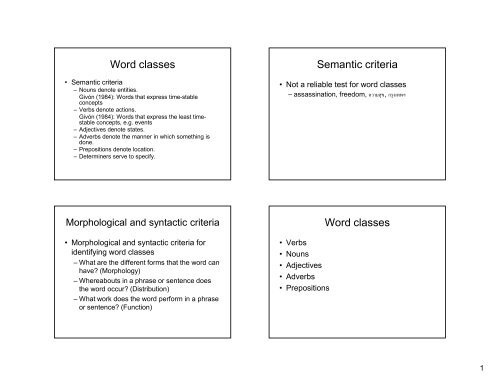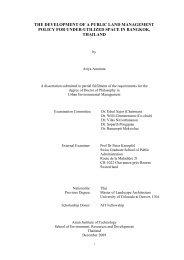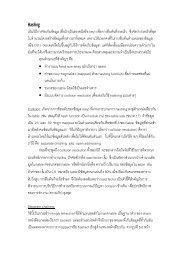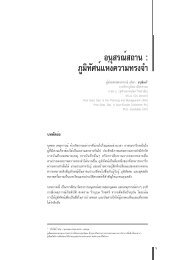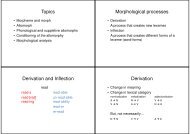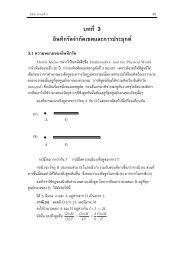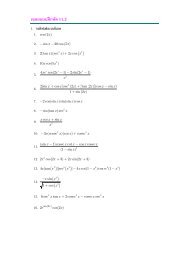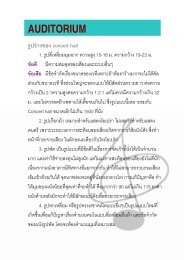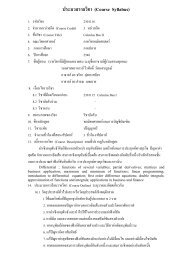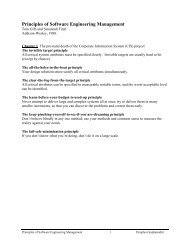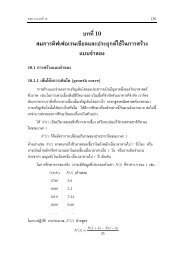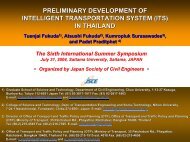Word classes Semantic criteria Word classes - Pioneer.chula.ac.th
Word classes Semantic criteria Word classes - Pioneer.chula.ac.th
Word classes Semantic criteria Word classes - Pioneer.chula.ac.th
Create successful ePaper yourself
Turn your PDF publications into a flip-book with our unique Google optimized e-Paper software.
<strong>Word</strong> <strong>classes</strong><br />
• <strong>Semantic</strong> <strong>criteria</strong><br />
– Nouns denote entities.<br />
Givón (1984): <strong>Word</strong>s <strong>th</strong>at express time-stable<br />
concepts<br />
– Verbs denote <strong>ac</strong>tions.<br />
Givón (1984): <strong>Word</strong>s <strong>th</strong>at express <strong>th</strong>e least timestable<br />
concepts, e.g. events<br />
– Adjectives denote states.<br />
– Adverbs denote <strong>th</strong>e manner in which some<strong>th</strong>ing is<br />
done.<br />
– Prepositions denote location.<br />
– Determiners serve to specify.<br />
<strong>Semantic</strong> <strong>criteria</strong><br />
• Not a reliable test for word <strong>classes</strong><br />
– assassination, freedom, ความสุข, กรุงเทพฯ<br />
Morphological and synt<strong>ac</strong>tic <strong>criteria</strong><br />
• Morphological and synt<strong>ac</strong>tic <strong>criteria</strong> for<br />
identifying word <strong>classes</strong><br />
– What are <strong>th</strong>e different forms <strong>th</strong>at <strong>th</strong>e word can<br />
have (Morphology)<br />
– Whereabouts in a phrase or sentence does<br />
<strong>th</strong>e word occur (Distribution)<br />
– What work does <strong>th</strong>e word perform in a phrase<br />
or sentence (Function)<br />
• Verbs<br />
• Nouns<br />
• Adjectives<br />
• Adverbs<br />
• Prepositions<br />
<strong>Word</strong> <strong>classes</strong><br />
1
Verbs<br />
• Morphological <strong>criteria</strong><br />
– Base form<br />
– Present tense –s<br />
– Past tense –ed<br />
– Participle<br />
– Gerund –ing<br />
• Distinguish verbs from modals (modal<br />
auxiliaries)<br />
Verbs<br />
• Synt<strong>ac</strong>tic <strong>criteria</strong><br />
– Distribution<br />
Pat _____ her cat.<br />
Sam can _____ a monkey.<br />
Mary wanted to _____.<br />
– Function<br />
Predicates (denote situations, events, <strong>ac</strong>tions,<br />
processes, etc.)<br />
Arguments<br />
• Participants in an event<br />
– John ran.<br />
Intransitive<br />
– John hit Bill.<br />
Transitive<br />
– John gave a present to Bill.<br />
Ditransitive<br />
<strong>Semantic</strong> roles<br />
• Agent, Patient, Experiencer, Recipient,<br />
Goal, Force, Instrument<br />
• Arguments and semantic roles<br />
– John and Bill laughed.<br />
– John and Bill killed two rats.<br />
– Tea, I like.<br />
2
Nouns<br />
• Morphological <strong>criteria</strong><br />
• Synt<strong>ac</strong>tic <strong>criteria</strong><br />
– Distribution<br />
– Function<br />
Arguments of predicates<br />
Grammatical relations: Subject, Object (Direct<br />
object, Indirect object, Prepositional object)<br />
Criteria for subjec<strong>th</strong>ood<br />
(1) In <strong>th</strong>e garden was a rabbit.<br />
(2) John is a te<strong>ac</strong>her.<br />
(3) Mary doesn’t like apples.<br />
(4) These pictures were painted by John.<br />
Criteria for subjec<strong>th</strong>ood<br />
• Control subject-verb agreement (in terms<br />
of person and number)<br />
• Nominative case marking (seen in<br />
pronouns)<br />
• Canonical position: right before <strong>th</strong>e verb<br />
Nouns and predicative function<br />
• Noun phrases can be predicates, and in<br />
some languages a copula verb is not<br />
present.<br />
3
Adjectives<br />
• Morphological <strong>criteria</strong><br />
• Synt<strong>ac</strong>tic <strong>criteria</strong><br />
– Distribution<br />
He is very/too/quite _____.<br />
Degree modifiers<br />
– Function<br />
Attributive and predicative functions<br />
Functions of APs<br />
• Attributive APs modify a noun and<br />
normally have a fixed position.<br />
– a round table, a bl<strong>ac</strong>k book<br />
– une table ronde, un livre noir<br />
• Predicative APs<br />
– He felt tired/happy/bad.<br />
– She is nice/smart/jealous.<br />
Functions of APs<br />
• Predicative APs occur wi<strong>th</strong> a copula verb<br />
in English, but not in many o<strong>th</strong>er<br />
languages.<br />
• Some adjectives in English can only be<br />
used as predicative adjectives or<br />
attributive adjectives, e.g., awake, utter.<br />
Are adjectives essential<br />
• A closed class in Igbo<br />
• Languages express concepts differently.<br />
He is happy.<br />
เขามีความสุข<br />
4
Prasi<strong>th</strong>ra<strong>th</strong>sint (2000)<br />
• There are languages which have no<br />
category of adjectives.<br />
• Adjectives in Thai are in f<strong>ac</strong>t verbs.<br />
Prasi<strong>th</strong>ra<strong>th</strong>sint (2000)<br />
• Functional criterion: verb and adjective<br />
• <strong>Semantic</strong> criterion: adjective<br />
• Synt<strong>ac</strong>tic criterion: verb<br />
Prasi<strong>th</strong>ra<strong>th</strong>sint (2000)<br />
• Proposed <strong>th</strong>at NP+“Adjective” is a relative<br />
clause in which <strong>th</strong>îi can be absent.<br />
• Verb-like behaviors<br />
– Occurrence in predicative position<br />
– Negation<br />
– Imperative<br />
– Co-occurrence wi<strong>th</strong> words signifying aspects<br />
Prasi<strong>th</strong>ra<strong>th</strong>sint (2000)<br />
• Verbs behave like “adjectives”.<br />
– Nominal modification<br />
– Nominalization<br />
– Intensification<br />
– Comparison<br />
– Co-occurrence wi<strong>th</strong> classifiers<br />
5
Prasi<strong>th</strong>ra<strong>th</strong>sint (2000)<br />
• Thai expresses adjectival concepts<br />
<strong>th</strong>rough verbs.<br />
– Can be separated from <strong>ac</strong>tion verbs<br />
– “adjectival verbs” (Matisoff 1973)<br />
Post (2008)<br />
• Questioned <strong>th</strong>e claim <strong>th</strong>at Thai does not<br />
have adjectives<br />
• Examined <strong>th</strong>e internal structure of <strong>th</strong>e Thai<br />
adjective class and compared behaviors of<br />
adjectives wi<strong>th</strong> <strong>th</strong>ose of members of o<strong>th</strong>er<br />
word <strong>classes</strong><br />
Post (2008)<br />
• Adjectives are terms <strong>th</strong>at denote property<br />
concepts.<br />
• Terms denoting property concepts in Thai<br />
classified into verblike and nounlike forms.<br />
Post (2008)<br />
• Adjectives in Thai exhibit behaviors and<br />
distributional patterns <strong>th</strong>at are similar and<br />
different from stative and <strong>ac</strong>tive verbs.<br />
• Nominalization<br />
Only adjectives and non-core verbs can<br />
take khwaam.<br />
6
Post (2008)<br />
• Adnominal modification<br />
– Attributive clause<br />
[คน [พูดภาษาอังกฤษ]] ชอบมาออสเตรเลีย<br />
– Relative clause<br />
[คน [ทีพูดภาษาอังกฤษ]] ชอบมาออสเตรเลีย<br />
Adjectival modification wi<strong>th</strong> attributive<br />
clauses, and verbal modification wi<strong>th</strong> relative<br />
clauses.<br />
Post (2008)<br />
• Adjectives in Thai can be distinguished<br />
from verbs on distributional grounds.<br />
• There is a class of terms in Thai <strong>th</strong>at is<br />
similar to <strong>th</strong>e adjectives <strong>classes</strong> in many<br />
languages.<br />
• Thai cannot be used as evidence for <strong>th</strong>e<br />
existence of a language <strong>th</strong>at does not treat<br />
property concept words differently from<br />
o<strong>th</strong>er types of words.<br />
Prepositions<br />
• Distributional properties<br />
It was right _____ <strong>th</strong>e bed.<br />
• Functions<br />
– Mark location and time<br />
– Express manner in which an event is carried<br />
out, modify verbs<br />
(A PP can be an adverbial.)<br />
Adverbs<br />
• Morphological <strong>criteria</strong><br />
• Synt<strong>ac</strong>tic <strong>criteria</strong><br />
– Distribution<br />
He treats her _____.<br />
His _____ red shirt was stolen.<br />
He sings very _____.<br />
– Function<br />
Modify verbs, adjectives, and adverbs<br />
• Adjectives and adverbs are similar.<br />
7
Grammatical categories<br />
• Different types of grammatical categories<br />
– Inherent<br />
– Agreement<br />
– Relational<br />
• Can be represented in 2 ways<br />
– Change in form (e.g., affix)<br />
– Use a closed class word<br />
Grammatical categories for nouns<br />
• Number<br />
• Gender or noun class<br />
– Generally marked on nouns<br />
– Bantu languages: extensive noun class<br />
systems<br />
• Definiteness<br />
• Case<br />
Grammatical categories for verbs<br />
• Tense: systematic coding of <strong>th</strong>e relation<br />
between two points of time (reference time<br />
and event time)<br />
• The default temporal reference point which<br />
event/state clauses are anchored is <strong>th</strong>e<br />
time of speech.<br />
• Absolute tense, relative tense<br />
• Past, Future, Present (Habitual)<br />
Grammatical categories for verbs<br />
• Languages may have sub-divisions of<br />
tense (remote and recent past, immediate<br />
and distance future.<br />
– English: past, present (non-past)<br />
– Cross-linguistic differences: Past and nonpast,<br />
Future and non-future<br />
8
Grammatical categories for verbs<br />
• Aspect<br />
– Inherent (lexical) aspect vs. grammatical<br />
aspect<br />
• Perfective: perspective focus on<br />
termination and boundedness<br />
Imperfective: perspective focus away from<br />
termination and boundedness<br />
– Progressive: ongoing process<br />
– Habitual: repeated events<br />
Grammatical categories for verbs<br />
• Inter<strong>ac</strong>tion between inherent aspect and<br />
grammatical aspect<br />
He shot <strong>th</strong>e gun.<br />
He was shooting <strong>th</strong>e gun.<br />
She left <strong>th</strong>e house.<br />
She was leaving <strong>th</strong>e house.<br />
• Perfect<br />
Grammatical categories for verbs<br />
• Modality<br />
– Deontic modality: <strong>th</strong>e speaker’s intention to<br />
influence o<strong>th</strong>ers’ <strong>ac</strong>tion (obligation and<br />
permission)<br />
– Epistemic modality: addition of information<br />
regarding <strong>th</strong>e nature of proposition<br />
(conjectural, evidentiality)<br />
• Mood<br />
Actual and hypo<strong>th</strong>etical events<br />
Indicative, subjunctive<br />
Grammatical categories for verbs<br />
• Voice<br />
Active and passive<br />
• Agreement<br />
Person and number<br />
Gender or noun class<br />
9
Grammatical categories for<br />
adjectives<br />
• Comparison<br />
• Agreement<br />
Grammatical categories<br />
• How grammatical information is expressed<br />
depends on morphology in <strong>th</strong>e language.<br />
10


